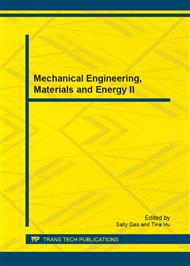[1]
GORDON R J , WILLIAM H C. A constitutive model and data for metals subjected to large strains high strain rates and high temperatures[J]. Proceedings of the Seventh Intional Symposium on Ballistics , The hague, The Netherlands , 1983, April 19-21: 541~547.
Google Scholar
[2]
SHI J, LIU C R. The influence of material models on finite element simulation of machining[J]. Journal of Manufacturing Science and Engineering. 2004, 126 : 849~857.
DOI: 10.1115/1.1813473
Google Scholar
[3]
LIANG R, KHAN A S. A critical review of experimental results and constitutive models for BCC and FCC metals over a wide range of strain rates and temperatures [J]. International Journal of Plasticity. 1999, 15: 963~980.
DOI: 10.1016/s0749-6419(99)00021-2
Google Scholar
[4]
HOPKINSON B. A method of measuring the pressure produced in the deformation of high explosives or by the impact of bullets [J]. Phil. Trans. Roy. Soc. 1914, A213: 437~452.
Google Scholar
[5]
KOLSKY H. An Investigation of the Mechanical Properties of Materials at very High Rates of Loading. Proc. Phys. Soc, 1949, B 62: 676.
DOI: 10.1088/0370-1301/62/11/302
Google Scholar
[6]
TOUNSIA N, VINCENTI J, OTHO A, et al. From the basic mechanics of orthogonal metal cutting toward the identification of the constitutive equation [J]. International Journal of Machine Tools & Manufacture. 2002, 42: 1373–1383.
DOI: 10.1016/s0890-6955(02)00046-9
Google Scholar
[7]
GUO Y B. An integral method to determine the mechanical behavior of materials in metal cutting [J]. Journal of Materials Processing Technology, 2007, 142: 72–81.
DOI: 10.1016/s0924-0136(03)00462-x
Google Scholar
[8]
PUJANA J, ARRAZOLA P J, SAOUBI R M, et al. Analysis of the inverse identification of constitutive equations applied in orthogonal cutting process [J]. International Journal of Machine Tools & Manufacture. 2007, 47: 2153–2161.
DOI: 10.1016/j.ijmachtools.2007.04.012
Google Scholar
[9]
LEE W S, LIN C F. High-temperature deformation behavior of Ti6Al4V alloy evaluated by high strain-rate compression tests [J]. Journal of Materials Processing Technology. 1998, 75: 127–136.
DOI: 10.1016/s0924-0136(97)00302-6
Google Scholar
[10]
HUBERT W. MEYER J R. DAVID S, et al. modeling the high strain rate behavior of titanium undergoing ballistic impact and penetration [J]. International Journal of Impact Engineering. 2001, 26: 509-521.
DOI: 10.1016/s0734-743x(01)00107-5
Google Scholar
[11]
CHAPARRO B M, THUILLIER S, MENEZES L F, et al. Material parameters identification: Gradient-based, genetic and hybrid optimization algorithms [J]. Comp. Mater. Sci. 2008, 44: 339–346.
DOI: 10.1016/j.commatsci.2008.03.028
Google Scholar
[12]
SASSO M, NEWAZ G, AMODIO D. Material characterization at high strain rate by Hopkinson bar tests and finite element optimization [J]. , Mater. Sci. Eng. 2008, A 487: 289–300.
DOI: 10.1016/j.msea.2007.10.042
Google Scholar
[13]
OZEL T, ZEREN E. Determination of work material flow stress and friction for FEA of machining using orthogonal cutting tests [J]. Journal of Materials Processing Technology. 2004, 153: 1019–1025.
DOI: 10.1016/j.jmatprotec.2004.04.162
Google Scholar
[14]
SHATLA M, KERK C, ALTAN T. Process modeling in machining. Part I: determination of flow stress data [J]. International Journal of Machine Tools & Manufacture. 2001, 41: 1511–1534.
DOI: 10.1016/s0890-6955(01)00016-5
Google Scholar
[15]
UMBRELLO D. Finite element simulation of conventional and high speed machining of Ti6Al4V alloy [J]. Journal of Materials Processing Technology. (2007).
DOI: 10.1016/j.jmatprotec.2007.05.007
Google Scholar


